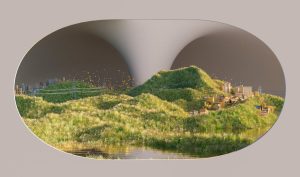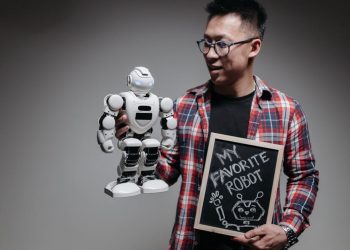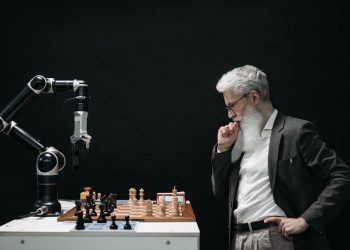No products in the cart.
AI Revolutionizing Museum Careers: The Rise of Smart Curatorship
Explore how AI is redefining museum careers, creating innovative curator-tech hybrids that enhance visitor experiences and redefine curation.
In a world where technology often feels like a distant star, unreachable and untouchable, there exists a realm where it collides beautifully with the past. Museums, those hallowed halls of history and culture, are not just preserving artifacts; they are now at the forefront of technological innovation. Welcome to the age of smart curatorship, where artificial intelligence (AI) is not merely a tool but a partner in storytelling.
Imagine walking into a museum that knows your interests better than you do. As you pass through its grand doors, an AI system recognizes you from your previous visits, tailoring your experience with personalized exhibits and interactive displays that speak directly to your passions. This isn’t a scene from a futuristic film; it’s the reality being crafted in museums worldwide.

The integration of AI into museum careers is creating hybrid roles that blend traditional curatorship with digital innovation. Museums are no longer just institutions of preservation; they are evolving into dynamic spaces where technology breathes new life into age-old narratives.
The Digital Transformation of Museums
The pandemic acted as a catalyst, accelerating the digital transformation of museums. With physical doors closed, many institutions turned to virtual reality, online exhibits, and AI-driven content to engage audiences. According to a report by the American Alliance of Museums, 47% of museums increased their digital engagement during the pandemic, showcasing a resilience and adaptability that will shape their future [1].
 Career Advice
Career AdviceNetworking Mistakes Students Make in the U.S. and How to Avoid Them
Students often stumble in networking situations. Learn about common mistakes and the art of relationship building in the U.S. educational…
Read More →According to a report by the American Alliance of Museums, 47% of museums increased their digital engagement during the pandemic, showcasing a resilience and adaptability that will shape their future [1].
Take the Louvre, for instance. This iconic museum has embarked on an ambitious project to digitize its entire collection, utilizing AI algorithms to analyze visitor preferences and optimize exhibit layouts. The goal? To ensure that every visitor, whether in-person or online, engages with the art in a way that resonates deeply with them.
But it’s not just about enhancing visitor experiences. AI is also aiding curators in research and conservation. Advanced imaging technologies allow for the analysis of artworks at a molecular level, revealing details that were previously hidden. This means that curators can make informed decisions about restoration and conservation, ensuring that these treasures are preserved for future generations.
The New Era of Curatorship
As museums embrace this technological renaissance, the role of a curator is evolving. No longer just gatekeepers of culture, curators are becoming data analysts, storytellers, and tech-savvy innovators. The curator of the future must navigate the complexities of both art and technology, balancing the emotional weight of history with the precision of data analytics.
At the heart of this transformation lies the concept of the ‘smart curator’. These professionals are not just curating exhibits; they are curating experiences. They leverage AI to analyze visitor data, identify trends, and create exhibits that resonate on a personal level. For example, the Smithsonian Institution employs AI to analyze visitor feedback, tailoring exhibits to enhance engagement and satisfaction [2].
 AI
AIAI’s Role in Shaping Careers in the Middle East’s Oil and Energy Sectors
AI is reshaping careers in the Middle East's oil and energy sectors, creating new opportunities and driving diversification. Explore the…
Read More →Yet, this shift raises important questions about the future of curatorship. Is there a risk of losing the human touch in the artistic storytelling process? As AI takes on more responsibilities, how do we ensure that the soul of curation—its emotional and cultural significance—remains intact?
These questions are not merely theoretical. They reflect the broader tension between technology and humanity. The challenge for museums lies in finding a balance—using AI to enhance experiences without overshadowing the very essence of what makes art and culture worthwhile.
Yet, this shift raises important questions about the future of curatorship.
Looking Ahead: A Collaborative Future
As we gaze into the horizon, the future of museums and curatorship looks promising yet complex. The collaboration between human curators and AI technology presents an exciting opportunity to redefine cultural engagement. The key will lie in the thoughtful integration of technology, ensuring that it serves as a complement to, rather than a replacement for, human creativity and insight.
For aspiring professionals in the field, this evolution offers a wealth of opportunities. Roles that blend art history with data science, digital marketing, and user experience design are becoming increasingly prevalent. The museum of the future will require a new breed of talent—individuals who can bridge the gap between the past and the present, art and technology.
 Blockchain
BlockchainBeyond the Bell: Charting Personalized Career Journeys from the Classroom
Forward-thinking school districts are revolutionizing education by implementing comprehensive career pathways, empowering students to explore diverse professional opportunities and develop…
Read More →As museums continue to navigate this digital landscape, they will undoubtedly face challenges. Yet, the potential for innovation and engagement is boundless. The smart curator of tomorrow will not just tell stories of the past; they will shape the narratives of the future, crafting experiences that inspire, educate, and connect us all.











